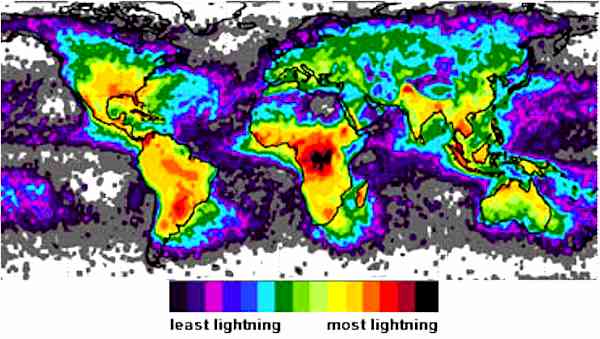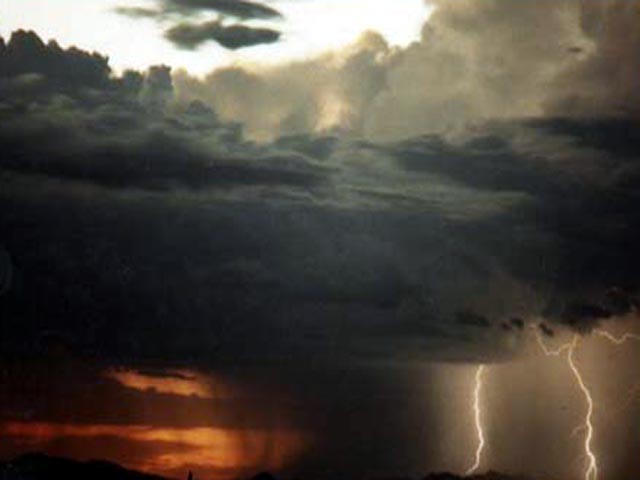Greased Lightning
Enlightening LightningIf you are caught on a golf course during a storm and are afraid of lightning, hold up a 1-iron. - Lee Trevino
© Patrick EMIN 1991 webmaster@cadxp.info by Brian J Soden The extent to which the Earth's climate will warm as a result of increasing carbon dioxide in the atmosphere depends largely on the response of water vapour in the upper levels of the troposphere (roughly 5 - 10 km above the surface). But our ability to monitor changes in water vapour there is limited by the scarcity of observing systems with sufficient accuracy and longevity to document its global variation and to detect trends. On page 290 of this issue[1], Price demonstrates a remarkably robust relationship between upper tropospheric water vapour and global lightning activity. This observation not only supports the idea that atmospheric convection moistens the upper troposphere, a characteristic of climate models that has been the subject of a spirited debate [2], but may also provide a unique tool for monitoring purposes. The importance of water vapour in regulating climate is without question. It is the dominant greenhouse gas, trapping more of the Earth's heat than any other gaseous constituent of the atmosphere. If water vapour concentrations increase in a warmer world, as is widely believed, the added absorption will act to further amplify the initial warming. Mathematical models of the Earth's climate suggest that this would provide considerable positive feedback, more than doubling the sensitivity of surface temperature to anthropogenic greenhouse gases. Current models predict that water vapour concentrations in the upper troposphere could increase by as much as 40% over the next half-century.[3] This amplified moistening in response to the predicted warming not only highlights the significance of water vapour as a feedback mechanism, but also underscores the need for long-term monitoring of upper-tropospheric water vapour in helping to detect climate change and identify its causes. Some climate researchers have challenged this view. They argue that the treatment of water vapour in climate models is overly simplified and that concentrations in the upper troposphere might actually decrease in a warmer climate. The mechanisms and effects of atmospheric convection and related cloud processes have been central to this debate.
Lindzen [2] postulated that the increased convective overturning of the atmosphere in response to warmer surface temperatures would bring more dry air down from higher altitudes and decrease the moisture in the upper troposphere. That atmospheric convection locally moistens the environment in which it occurs is indisputable. Observations from weather satellites (Figure 1) clearly show increased levels of humidity (yellow to red) in regions surrounding the areas of active convection, as can be seen from the upper-level cloud cover (grey). However, on a global scale, the net effect of an increase in convective overturning is less obvious. Rising air in convective towers must be balanced in surrounding regions by sinking air, which, in the absence of other sources of moisture, can lead to extremely dry conditions in the upper troposphere (blue in Figure 1). Price[1] uses global lightning activity as a proxy for atmospheric convection. This is reasonable because convection not only determines the vertical transport of moisture, but also influences the electrification processes responsible for generating lightning activity. He shows that variations in lightning are well correlated with the observed fluctuations in global upper-tropospheric moisture on both weekly and seasonal timescales. Some may rightly question the reliability of current systems for observing moisture levels, such as the satellite output that Price has used. But he shows that similar variations in water vapour are obtained using independent measurements from different observing systems, which lends further credibility to the results. By itself, the strong correlation between lightning activity and upper tropospheric water vapour offers a valuable opportunity for testing model simulations of the response of moisture to changes in atmospheric convection. But Price also points out that global lightning activity can be readily monitored from a single location through so-called Schumann resonances, the low-frequency electromagnetic waves discharged by lightning. Because these waves become trapped in the wave guide formed by the Earth's ionosphere, they can travel around the globe several times before dissipating. This means that global monitoring can be done from a single location. Given the close relationship between lightning and upper-tropospheric water vapour, Price suggests that measurements of Schumann resonances could provide an inexpensive method for monitoring the long-term trends in upper-tropospheric moisture. Water vapour is notoriously difficult to measure and such a capability would be of great value to the climate research community. Water vapour is highly variable in both space and time (Figure 1), and its concentration in the atmosphere varies by over three orders of magnitude. Although an international network of weather balloons has carried water vapour sensors for nearly half a century, changes in instrumentation and poor calibration make such sensors unsuitable for detecting trends in upper-tropospheric water vapour. Likewise, although weather satellites have provided global measurements of water vapour for over two decades, little effort has gone into making the data appropriate for long-term climate monitoring. Price has shown that seasonal changes in global lightning activity are well correlated with changes in water vapour in the upper troposphere, but it remains to be seen whether the long-term trends in these quantities exhibit similar consistency. If Price's optimism proves correct, and future trends in lightning activity can indeed be linked to trends in upper-tropospheric water vapour, observations of Schumann resonances could provide a great deal of enlightenment in tracking climate change. Brian I Soden is at the NOAA Geophysical Fluid Dynamics Laboratory, Princeton University, PO Box 308, Princeton, New Jersey 08542 USA e-mail: bjs@gfdl.gov [1] Price, C Nature 406. 290-293 (2000) [2] Lindzen, R S Bulletin of the American Meteorological Society 71, 288-299 (1990) [3] Rind, D Science 281, 1152-1153 (1998). Source: Nature Vol 406 20 July 2000\
Cellphone Could Have Led to Death of Tourist on Great WallBeijing - A mobile phone could have led to the death of a 25-year-old Greek tourist who was struck by a bolt of lightening on the Great Wall near Beijing. Mobile phones in use can induce lightning strikes," said an employee surnamed Wang with the management office at the Simatai section of the Great Wall. She said yesterday that the Simatai section of the wall was equipped with lightning rods that are supposed to protect people from being struck, but "it was possible" that the tragedy was caused by the mobile phones the Greek woman and her male companion had on them. The 30-year-old Greek man was slightly injured. Wang said, "We usually advise tourists to turn off their mobile phones in stormy weathers." Last year, 10 tourists seeking shelter from the rain in a beacon tower at Juyong Pass, another section of the Great Wall, were also struck by lightning when one of them was using a mobile phone. Fortunately, no one was seriously injured. Experts warn that in stormy weather, tourists should turn off their mobile phones in open areas, and stay away from lakes, ponds, trees, wire poles and pavilions, which are often hit by lightening. The latest accident occurred just after noon on Friday. Medical workers reached the spot just over an hour later and found the woman already dead. A local villager selling souvenirs on the Great Wall said there was only a little rain in the morning, but it developed into a thunderstorm around noon. "The thunder roared and lightning flashed, with strong winds and heavy rain," he recalled. "We all rushed down the hill for fear of being hit by a bolt of lightening." The employee with the management office said they stopped selling tickets for the wall at about 12:30 pm because of the thunderstorm. Source: news.xinhuanet.com 15 August 2005 originally from China Daily See also:
Source: cellar.org
Lightning's X-ray Zap
A hi-tech version of Franklin's experiments Lightning does emit X-rays, scientists have confirmed. A new study settles a long-standing debate dating back to 1925 when it was first suggested that thunderstorms might produce high-energy radiation. A team from the University of Florida's International Centre for Lightning Research and Testing triggered strikes by firing rockets trailing grounded wires into storm clouds. The induced lightning hit a specially constructed tower, allowing the team to study the discharges in detail. They measured intense bursts of x-rays, gamma rays and fast-moving electrons - just before each visible flash. The bursts typically lasted less than 100 microseconds. "I think it's really exciting," said co-researcher Martin Uman. "We didn't expect to see anything at all, and then, all of a sudden, with almost every lightning stroke, we had x-rays." The presence of x-rays has been suspected for some time (recent data have hinted in this direction), but confirmation has proved difficult because of the sporadic nature of lightning and the electromagnetic "noise" it generates. Uman, Joseph Dwyer and colleagues suggest that the breakdown of air - the process thought to generate the x-rays - is an important process for lightning and other atmospheric discharge phenomena. The x-rays and other radiation may be generated when large electric fields manipulate electrons during the "dart leader", the phase that creates a path from clouds to ground for the lightning to follow during a strike. "These results provide strong evidence that the production of runaway electrons is an important process during lightning," the researchers wrote in the journal Science. The technique used to trigger and control the strikes is a hi-tech version of the famous kite method for inducing lightning bolts used by Ben Franklin in 1752. Researchers hope it can be further developed to study phenomena such as sprites, the strange lightning observed by jet pilots above clouds. Source: news.bbc.co.uk Friday 31 January 2003
Lightning Provides Vital Spark for Evolutionby Scott Norris
Scientists commonly use electricity to increase the permeability of bacterial cell membranes, making it easier to insert DNA. Now Sandrine Demanèche's team at the University of Lyon has provided the first evidence that nature may have been wise to this trick all along. The researchers seeded soil samples with the E coli bacterium, as well as fragments of DNA containing genes for antibiotic resistance. They zapped the soil with a simulated lightning strike, and found that many of the bacteria had acquired the resistance genes. Bacteria are already known to take up and use foreign DNA released into the environment when other organisms die. Scientists knew this "horizontal gene transfer" occurs naturally in soil, but thought it was relatively rare. However, recent genomic research indicates that this gene take-up is widespread and has played a major role in the evolution of the bacterial genome. "This result might help explain the discrepancy between the very low observed rates of gene transfer and the apparently wide distribution of DNA sequences among bacteria," says team member Timothy Vogel. Lightning may seem relatively rare, but there are about a hundred flashes a second around the planet. Ground strikes almost always create currents in the surrounding soil similar to those from the simulated bolts, Vogel says. Journal reference: Applied and Environmental Microbiology (vol 67, p 3440) Source: www.newscientist.com 03 August 2001 Photo credit: Image Bank
First World Map of Lightning Activityby Will Knight
The first complete world map of lightning activity has been created using observations from two earth-orbiting satellites. Central Africa, the Himalayas and parts of South America experience more lightning than anywhere else on the planet, the map reveals. In an area centred around DR Congo, there are an average of 81 lightning flashes per square kilometre per year. The NASA map also shows that lightning very rarely occurs at sea and is almost never seen at the Earth's poles. "For the first time, we've been able to map the global distribution of lightning, noting its variation as a function of latitude, longitude and time of year," says Hugh Christian, project leader of NASA's National Space Science and Technology Center's lightning team. Lightning occurs when electrical potential builds up inside clouds, in the form of turbulence between ice crystals and water droplets with either a positive and negative charge. This electrical potential is discharged in the form of lightning, which can strike the ground, pass between two clouds and occur inside the same cloud. In central Africa, where lightning is most common, air flow from the Atlantic Ocean is enhanced by mountainous areas, causing turbulence all year round. Steve Goodman of NASA's Global Hydrology and Climate Center says the new data should improve scientist's understanding of and ability to predict extreme weather system. Two instruments were used to gather data for the aerial map. The Optical Transient detector was launched aboard NASA's Microlab satellite in 1995 and the Lightning Imaging Sensor is fitted to a joint NASA-Japan satellite launched in 1997 to measure tropical rainfall levels. The sensors gathered lightning data over periods of five and three years respectively. The first lightning maps were constructed from ground-based detectors, which left many parts of the world unmapped. In 1998, the Lightning Imaging Sensor first mapped the distribution of lightning strikes in a broad region around the equator. But many parts of the globe remained uncharted. The new combined data also provides more information about the intensity, as well as the frequency, of lightning activity. Source: www.newscientist.com 6 December 2001 Photo credit: US National Space Science and Technology Center
Desert Storm
Desert storm photo by John Harvey Source: www.desertusa.com
Lightning SafetyThe odds of being struck by lightning in the US are 1 in 240,000 each year - or 1 in 80,000 over an 80-year lifetime. Every person in Britain has a one in two million chance of being killed by lighting each year. This compares with a one in 8,000 chance of being killed in a traffic accident. The contact voltage of a typical industrial electrical shock is 20-63 kilovolts, while a lightning strike delivers about 300 kilovolts. Most of the current from a lightning strike passes over the surface of the body in a process called "external flashover." Both industrial shocks and lightning strikes result in deep burns at the point of contact. Pay attention and take proper precaution! Go inside a building or car (not a convertible!) with the windows rolled up if possible. Avoid metal. Don't stand under a tree, talk on a phone with a cord, take a bath or shower or wash dishes. Stay away from aluminium sliding patio doors. If possible, unplug your computer and modem. Eighty people are killed by lightning each year in the US and 300 are injured. Three percent of those killed were talking on a phone with a cord. If you are driving, pull over and turn your engine off (lightning can completely destroy your engine and car's electrical system - not a good idea to be going 60 miles an hour if that happens). Keep your hands off anything metal inside the car. If you are playing golf, put your clubs down and stay away from your cart. The six most common dangerous activities associated with lightning strikes, in order, are:
If caught in the open during a strike and the hair on your head or neck begins to stand on end (this really happens) go inside the nearest building. If no shelter is available, crouch down immediately in the lowest possible spot and roll up in a ball with feet on the ground. (DO NOT LIE DOWN.) Try to balance on the balls of your feet to minimise contact with the ground. Don't huddle with others - if one is struck, the lightning will bounce from person to person. Only 10 - 20% of lightning victims die as a result of being struck, but many suffer nervous-system damage, broken bones and/or a loss of hearing and/or eyesight. They can develop slowly, becoming apparent much later. Treatment:
Sources: thunder.msfc.nasa.gov 6 December 2001; Megan Ballinger quoting Richard Kithil, founder of the National Lightning Safety Institute in a 29 July 2003 Wall Street Journal article entitled "Lightning Can Indeed Strike: Summer Safety Tips"; news.telegraph.co.uk 12 August 2003, an article by science editor Roger Highfield entitled "So What Are the Chances of Being Struck and Killed?" which occasionally quotes Dr Elisabeth Gourbiere of Electricité de France
Lightning Strikes Couple in Iron BedTrying to sleep through a storm wasn't easy for a Norwegian couple - their cast-iron double bed took a direct hit from a lightning bolt that lit up the bedroom. Idar Roenningen and companion Charlotte Amundsen, both 28, were kept awake by thunder late Friday night at their country home outside Porsgrunn, 100km southwest of the capital, Oslo. So, Roenningen unplugged some appliances. Shortly after returning to bed, the room flared "like 10 welder's torches" and then everything went dark, Roenningen said. Smoke from charred electrical sockets traced through the room. Pillows apparently insulated the couple from the iron bed frame. They were not injured, but they chose to spend the rest of the night on the sofa. Their 5-year-old son, Jonathan, normally liked to sneak into bed with the couple, but he was away for a holiday break. Source: www.thecouriermail.news.com.au 28 July 2003 from correspondents in Oslo, Norway
Ball Lightning Baffles Scientists
Ball lightning over Queensland, Australia by Brett Porter This picture of the freak weather phenomenon of ball lightning was taken by a wildlife ranger in Queensland, Australia, in 1987. It has just been published after he read about ball lightning research and sent it to a scientist. Ball lightning occurs so rarely that few photographs of it exist and researchers have had to rely on eyewitness accounts, some of them from previous centuries. The term describes small natural fireballs which very occasionally follow ordinary lightning, floating across land or through buildings and aircraft. The UK Royal Society's journal Philosophical Transactions A outlines the current state of knowledge of the puzzling phenomenon.
One account referred to in the journal describes ball lightning seen in Papua New Guinea: "The ball of lightning (which was actually about the size of a cricket ball) came out of the clumps of bamboo, passed through the front wall of our house, moved very quickly through the lounge room and disappeared out the back wall. The ball of lightning moved at about head height and was clearly visible in ball form. After it came through our front wall, it did not move in a straight line to our back wall; in fact, it seemed to do a few little detours around the room before it passed through the back wall." There are several theories which might explain ball lightning. One says ordinary lightning sometimes causes matter to separate. Another says ordinary lightning hits the ground or a tree and dislodges a glowing mass. A third says fuel gases are ignited by electrical charges in the atmosphere and a fourth says the luminous globe is a product of electromagnetic radiation. Given the sparse evidence, it will be difficult for any of them to find clear proof in the near future. Source: news.bbc.co.uk Friday 21 December 2001; photo credit Brett Porter
Click to Begin
For pages on other natural disasters - including tornados, hurricanes, volcanoes, floods, global warming and more - as well as satellite photos and some great pictures
of trees, clicking the "Up" button immediately below takes you to the Table of Contents page for this Environment section. |
 Animals
Animals Animation
Animation Art of Playing Cards
Art of Playing Cards Drugs
Drugs Education
Education Environment
Environment Flying
Flying History
History Humour
Humour Immigration
Immigration Info/Tech
Info/Tech Intellectual/Entertaining
Intellectual/Entertaining Lifestyles
Lifestyles Men
Men Money/Politics/Law
Money/Politics/Law New Jersey
New Jersey Odds and Oddities
Odds and Oddities Older & Under
Older & Under Photography
Photography Prisons
Prisons Relationships
Relationships Science
Science Social/Cultural
Social/Cultural Terrorism
Terrorism Wellington
Wellington Working
Working Zero Return Investment
Zero Return Investment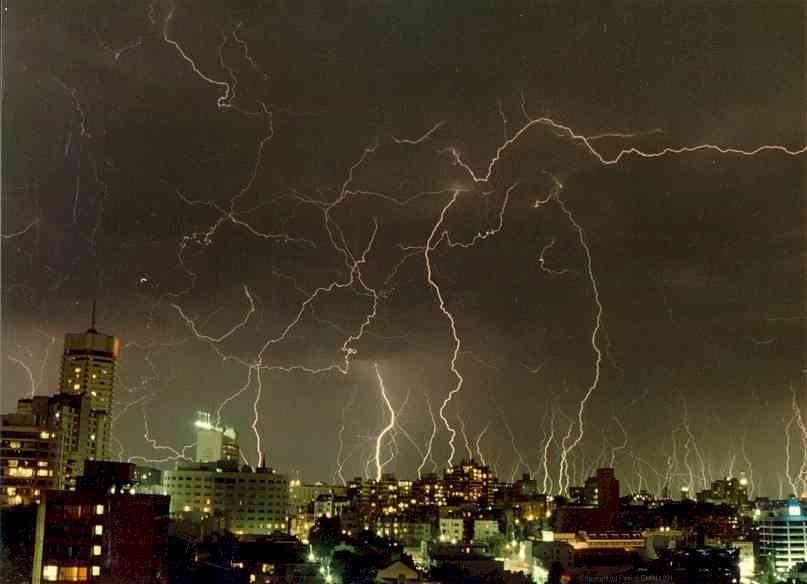



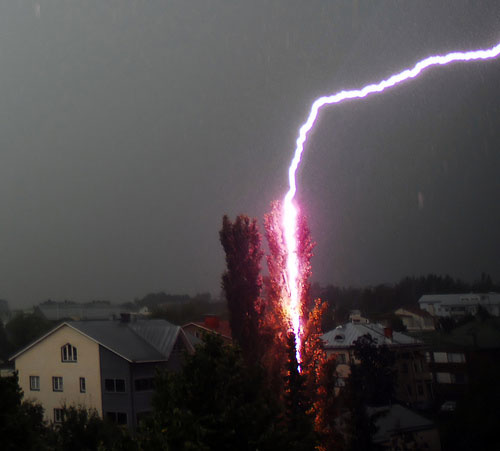

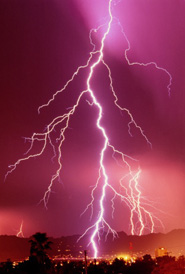 Bolts of lightning that strike the ground may help bacteria adapt and evolve. Experiments
suggest that electrical currents help soil bacteria exchange DNA.
Bolts of lightning that strike the ground may help bacteria adapt and evolve. Experiments
suggest that electrical currents help soil bacteria exchange DNA.